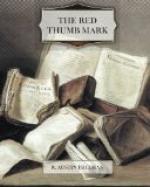Having completed the adjustments, he now examined afresh the blood-smears and the thumb-print, both by transmitted and reflected light, and I observed him hurriedly draw one or two diagrams in his notebook. Then he replaced the spectroscope and lamp in the case and brought forth the micrometer—a slip of rather thin glass about three inches by one and a half—which he laid over the thumb-print in the place of the upper plate of glass.
Having secured it in position by the clips, he moved it about, comparing its appearance with that of the lines on the large photograph, which he held in his hand. After a considerable amount of adjustment and readjustment, he appeared to be satisfied, for he remarked to me—
“I think I have got the lines in the same position as they are on our print, so, with Inspector Johnson’s assistance, we will take a photograph which we can examine at our leisure.”
He extracted the camera—a quarter-plate instrument—from its case and opened it. Then, having swung the microscope on its stand into a horizontal position, he produced from the camera case a slab of mahogany with three brass feet, on which he placed the camera, and which brought the latter to a level with the eye-piece of the microscope.
The front of the camera was fitted with a short sleeve of thin black leather, and into this the eye-piece end of the microscope was now passed, the sleeve being secured round the barrel of the microscope by a stout indiarubber band, thus producing a completely light-tight connection.
Everything was now ready for taking the photograph. The light from the window having been concentrated on the thumb-print by means of a condenser, Thorndyke proceeded to focus the image on the ground-glass screen with extreme care and then, slipping a small leather cap over the objective, introduced the dark slide and drew out the shutter.
“I will ask you to sit down and remain quite still while I make the exposure,” he said to me and the inspector. “A very little vibration is enough to destroy the sharpness of the image.”
We seated ourselves accordingly, and Thorndyke then removed the cap, standing motionless, watch in hand, while he exposed the first plate.
“We may as well take a second, in case this should not turn out quite perfect,” he said, as he replaced the cap and closed the shutter.
He reversed the dark slide and made another exposure in the same way, and then, having removed the micrometer and replaced it by a slip of plain glass, he made two more exposures.
“There are two plates left,” he remarked, as he drew out the second dark slide. “I think I will take a record of the blood-stain on them.”
He accordingly made two more exposures—one of the larger blood-stain and one of the smaller smears.
“There,” said he, with an air of satisfaction, as he proceeded to pack up what the inspector described as his “box of tricks.” “I think we have all the data that we can squeeze out of Scotland Yard, and I am very much obliged to you, Mr. Singleton, for giving so many facilities to your natural enemy, the counsel for the defence.”




